The elimination diet is an accurate protocol that can be used to resolve food sensitivity, allergies and intolerances.
The user must follow a strict set of rules and eat a highly restrictive diet for some time in order for it to be successful, thus making it one of our advanced nutrition protocols.
In this article you will learn how to do an elimination diet, why it works, and ways to use it to successfully to resolve food sensitivity, allergies and intolerances.
Before digging in, as a valued reader of the blog, I’d like to extend you an invitation to our upcoming and totally FREE online training workshop:
‘The Proven Nutrition Strategies of Elite Trainers’.
This workshop is for you if you want to finally learn the best nutrition protocols and evidenced-based strategies to help your clients achieve life-changing results.
This workshop is our most complete training on how to make nutrition coaching easy and profitable.
All you need to do to attend is click here to register your free spot.
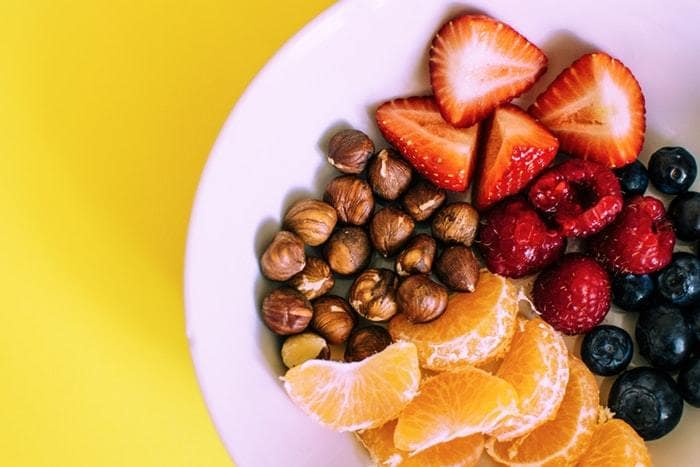
What is an Elimination Diet
In general we get two main types of clients:
1) Those with current eating habits that are poor or inconsistent, or
2) Those who are eating good food choices with consistency, yet not seeing results.
If a client falls into number 1, and eating habits are poor and lack any structure, the use of an elimination process is not required – they just need an improved diet.
However, it is possible that some clients may still not get the desired benefits/results from an improved diet, and it is therefore necessary to look a little deeper into their eating habits, particularly their food choices.
In my experience, it is food sensitivities or intolerances in the diet that may be causing a lack of results. Of course, this is assuming you have already addressed overall energy balance (calories in vs. calories out) to match current goals, macro and micronutrients breakdown, along with nutrient timing and frequency in the daily diet. If not, then this should be your starting point, and will actually be a much easier option.
It’s important to note that this is not a fat loss protocol, so it shouldn’t become the ‘go to’ diet for those who are having difficulty in losing bodyfat, but it could be an option.
Instead, it is likely to become one of your ‘go to’ diets to help treat those with the following conditions:
It is therefore a protocol that is based on improving the user’s health by removing food sensitivities and intolerances.
Of course, not everyone has been diagnosed with these conditions, and other symptoms or problems of the digestive system may prescribe the use of an elimination diet:
So this protocol is ideal for anyone who feels their gut is working sub optimally and is seeking improved body composition and health.
How It Works
Some of our clients will have food allergies and intolerances to certain food groups which can suppress hormones and disrupt the digestive system. This usually results in poor outcomes and despite people’s best efforts, progress can come to a complete halt.
As this area of nutrition coaching becomes more popular and is researched, it’s important to understand the difficulties between the terminologies when discussing it with clients:
1) Food allergy: an immediate food reaction that will always provide an immune response within minutes. The perfect example is a nut allergy, and this will always remain with the person.
2) Food sensitivity: a delayed reaction to foods which can take up to some days before symptoms are felt. Typical symptoms are diarrhoea, bloating, skin conditions, constipation and tiredness.
3) Food intolerances: defined as “an adverse physiological response to food(s)’” and, unlike allergies or sensitivities, there is no immunological mechanism of adverse food response. The perfect example is lactose intolerance, which essentially means you are lacking the enzyme lactose to aid digestion of lactose (milk/dairy).
It is important to find the foods causing these issues and remove them. For some people a general clean up of the diet works just fine, for others a stricter approach is needed.
How to Do an Elimination Diet
A good elimination diet is a strict, controlled eating plan that removes typical food intolerances along with those that may be individual to that person.
There are a number of ways on how to do an elimination diet, and one of the easiest places to start is to simply remove the common offenders:
Another approach is to make it more personal to the client by using a food diary (like the one contained in this article) to track the client’s food intake and link their symptoms to timing of meals and certain foods.
It can also be helpful to ask a few key questions:
This will allow you to create a more personal perspective of the client’s issues which may lead you to quicker results.
Often, the answers to these questions seem to be the foods that are most important to eliminate and test.
The last option is to head straight into the full elimination diet that will be the most restrictive, reducing all possible offenders.
Although this might sound daunting at first, it can be the quickest and most accurate method of all – the more you remove the more likely you are to discover foods you’re intolerant to.
When following this type of elimination diet, the following table gives an example of what to include and exclude:
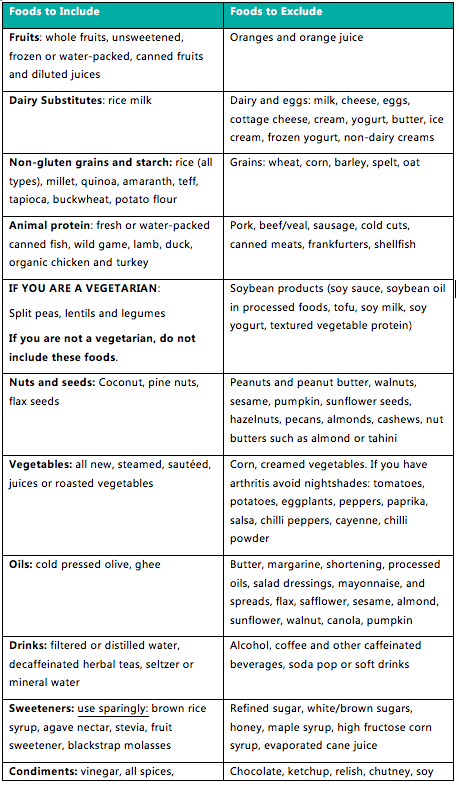
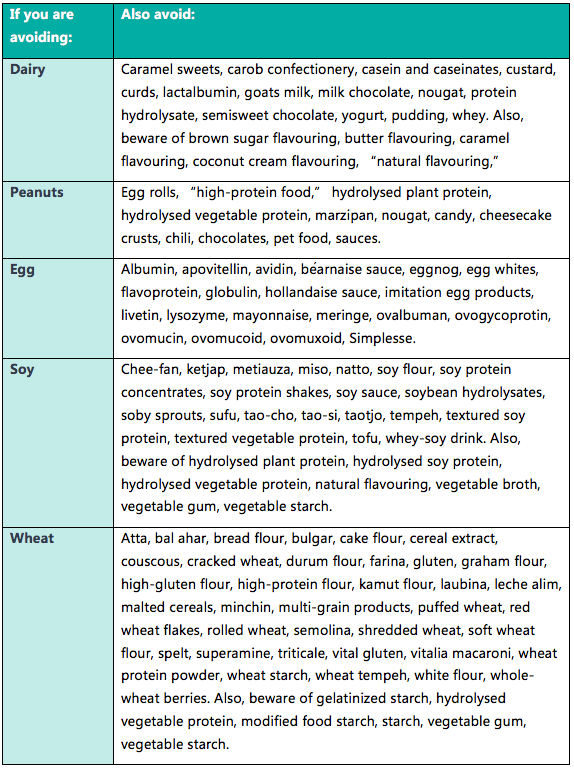
Although there are a number of tolerance tests now available, it is important to know that they may not show all intolerances and do not work as effectively as a good old fashioned elimination diet.
However, they are a good addition on how to do an elimination diet to ensure all bases have been covered.
Time
In order for the diet to work successfully, it is important to give it sufficient time in order to help heal the GI system, before testing.
This is usually anywhere between 2-4 weeks, depending on the severity of the problem initially. This is known as the removal phase.
Below is a typical elimination shopping list that can be used throughout the removal phase (unless known intolerances).
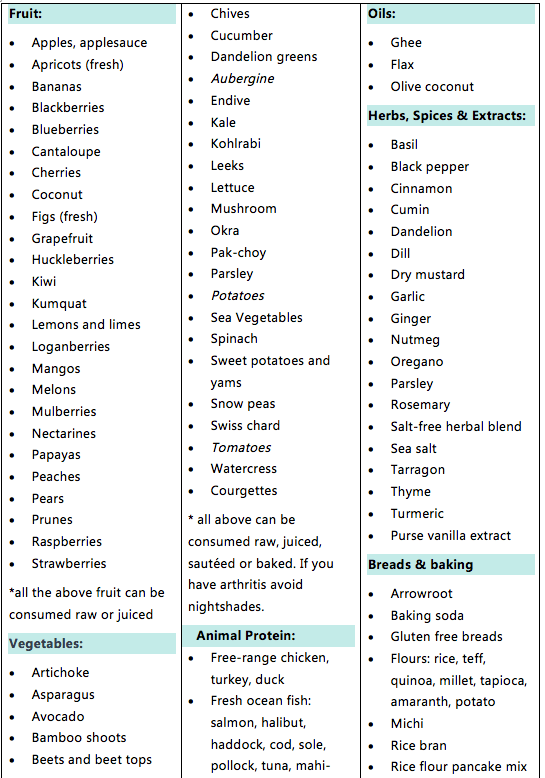
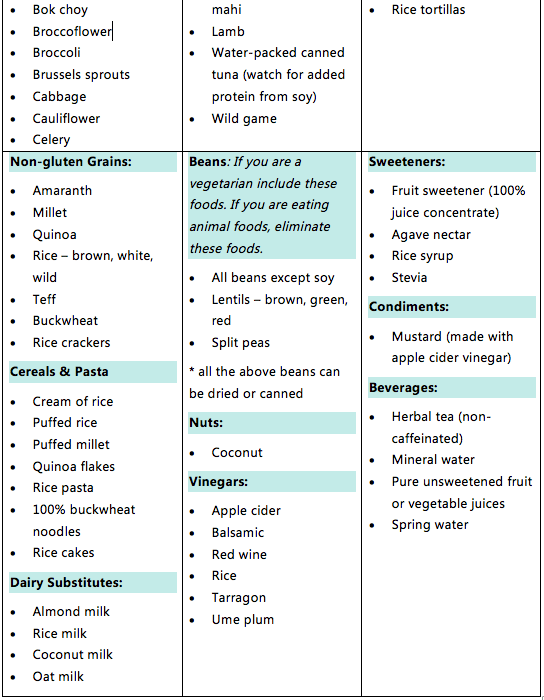
One of the further difficulties with this diet during the removal phase is coming up with great tasting meals with plenty of variety.
This tends to force people into eating a plain meat and veg diet which can result in poor dieting compliance with the protocol as people ‘fall off the wagon’ due to hunger and cravings.
It is important to highlight the importance of variation and some creativity when following the protocol, so below are some ideas to stimulate your own creativity.
BREAKFASTS:
LUNCH:
SNACK:
Again, it is important to avoid any foods that you know or believe may cause problems, even if they are on the ‘allowed’ list.
Re-Introduction
Once symptoms have improved it is time to start ‘challenging’ the body with the eliminated foods.
To challenge the body, add a food group every three days. It take three days to be sure that symptoms have time to come back if they are going to.
On the day that the eliminated food is tested again for the first time, start with just a small amount in the morning. If there are no symptoms, eat two larger portions in the afternoon and evening.
After a day of eating the new food, remove it, and wait for two days to see if you notice any symptoms. If a food doesn’t cause symptoms during the challenge, it is unlikely to be a problem food and can be introduced back into the diet. However, don’t add the food back until you have tested all the other foods on the list.
Below is a summary of the process just discussed;
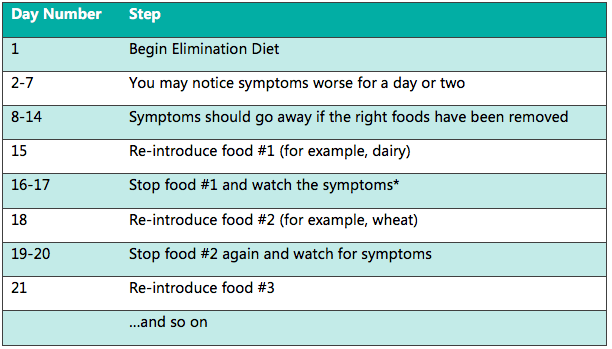
* you only eat a new food for one day. Do not add it back into your meal plan again until the elimination diet is over.
Throughout the removal and re-introduction phases it can be beneficial to keep a food log to track foods and possible symptoms in reaction to this.
The following food diary can be used to help with this:
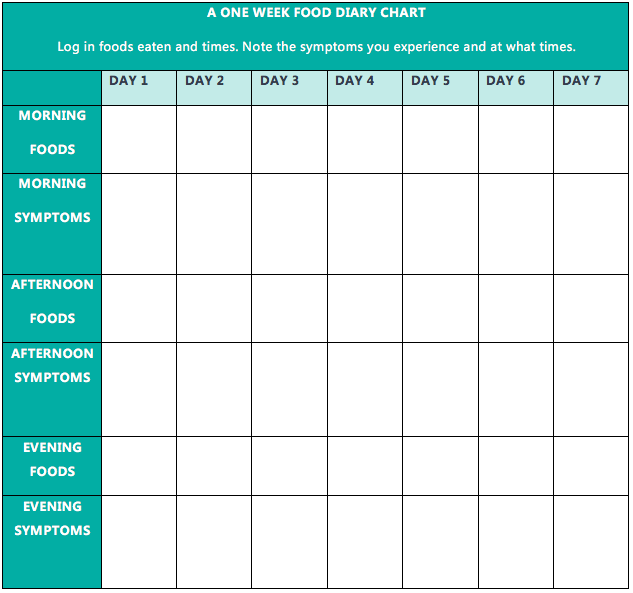
Benefits and Drawbacks
The key benefit from the elimination diet is it’s potential to reduce and even resolve any number of the health problems previously mentioned.
It is one of the best options for those suffering from GI issues, and can even reduce the need for medication. When used for the right symptoms, it really can make people healthy.
Another added benefit from following an elimination diet is the amount of biofeedback you get from your body in the process. By devoting a number of weeks to a detailed and restrictive eating plan you can learn a lot about how certain foods can affect you.
This experience is a great tool for anyone who is interested in understanding how nutrition can work for them. You learn a lot more than any test or medication protocol can show you.
The major downside to this is that it is hard. Even if you know that it may benefit a client, they may not want to do such a protocol due to its restrictiveness.
Also, if a client ‘falls off the wagon’ at any stage, the whole process may be ruined.
Many people notice that in the first week, especially in the first few days, their symptoms will become worse before they start to improve. If these continue, it’s important to see a medical practitioner.
On some occasions people will find that they still cannot source the problem and they have to repeat the process using a number of different foods as their base. At this point, some testing may be of benefit.
It is possible some clients will not go on to replace some of the eliminated foods and therefore missing out on adequate nutrition. For example, if a client gives up dairy, it is important to highlight a calcium supplement to replace this.
Overall this is a perfect test. It can also be confusing and difficult to truly track all of the issues or the ‘trigger’ foods. The key is to be consistent throughout the protocol.
Become an elite-level nutrition coach
My team and I have just finished up creating a brand new online training workshop called 'The Proven Nutrition Strategies of Elite Trainers.'
Best part? It costs you nothing. This is your official invite - all you need to do to attend is click here to register.
This free nutrition course is for you if you want to finally learn the best nutrition protocols and evidenced-based strategies to help your clients achieve life-changing results.
Join me and I’ll walk you through the exact steps you need to take in order to get incredible client results, boost your confidence and build your business with proven nutrition coaching strategies.

